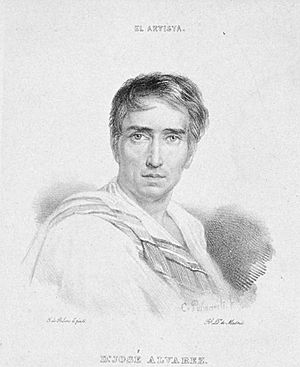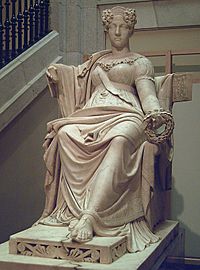José Álvarez Cubero facts for kids
José Álvarez Cubero (born April 23, 1768, died November 26, 1827) was a famous Spanish sculptor. He worked in the neoclassical style, which was popular at the time. This style was inspired by ancient Greek and Roman art. José spent much of his life creating art in cities like Paris and Rome.
Contents
Early Life and Training
José Álvarez de Pereira y Cubero was born in Priego de Córdoba, Spain, on April 23, 1768. His father was a stonemason, someone who works with stone. From a young age, José loved to draw and create models.
He learned sculpting from a French artist named Miguel Verdiguier in Cordova. Later, he continued his studies at the Academy of San Fernando in Madrid.
Journey to Paris and Rome
In 1799, King Charles IV of Spain gave José Álvarez a special grant. This money allowed him to travel to Paris and Rome to continue his art studies.
In 1804, while in Paris, he created a statue of Ganymede. This sculpture is now in the Museo del Prado in Madrid. It was so good that it quickly made him known as a leading sculptor. Because of his talent, his grant was doubled. He then moved to Rome, where he lived for most of the rest of his life.
While in Paris, Álvarez married Elizabeth Bougel. They had a son in 1805, who was also named José. This son also became a talented sculptor and painter, but he sadly passed away before he turned 25.
Working for Kings
José Álvarez Cubero was very loyal to Spain. He refused to accept Joseph Bonaparte as the King of Spain. Because of this, he was put in jail in Rome. After he was released, Napoleon I hired him to decorate the Quirinal Palace.
In 1816, he was named the official court sculptor for Ferdinand VII, the King of Spain. One of his most famous works was a sculpture of Antilochus and Memnon. King Ferdinand VII asked him to create this marble piece in 1818. It can now be seen in a museum in Madrid.
He also made several detailed sculptures of people's heads, called portrait busts. These included busts of King Ferdinand VII, the famous musician Rossini, and the Duchess of Alba. These sculptures were known for being very lifelike and strong.
Later Life and Legacy
After returning to Madrid, José Álvarez Cubero taught at the Academy of San Fernando. One of his students was a young artist named Ponciano Ponzano. Ponzano later became one of Spain's most famous neoclassical sculptors.
José Álvarez Cubero passed away in Madrid on November 26, 1827. He left behind a legacy of beautiful neoclassical sculptures.
Gallery
-
Maria Isabel of Portugal (1797–1818), sculpted in a Neoclassicist style. ca. 1826
See also
 In Spanish: José Álvarez Cubero para niños
In Spanish: José Álvarez Cubero para niños



